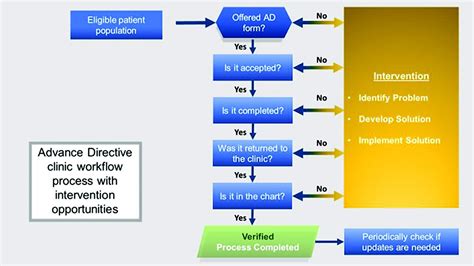Intro
Discover how Advance Directives work, ensuring end-of-life care, medical decisions, and living wills are respected, with 5 key methods for advance care planning, healthcare proxy, and durable power of attorney, securing patient autonomy and informed consent.
The importance of advance directives cannot be overstated, as they provide individuals with a sense of control and autonomy over their medical treatment, even when they are no longer able to communicate their wishes. Advance directives are documents that outline a person's preferences for medical care, should they become incapacitated or unable to make decisions for themselves. This can include decisions such as whether to receive life-sustaining treatments, such as CPR or mechanical ventilation, or whether to receive palliative care, which focuses on relieving symptoms and improving quality of life. By having an advance directive in place, individuals can ensure that their wishes are respected and that they receive the care that aligns with their values and goals.
Advance directives are particularly important for individuals who are facing serious illnesses or injuries, as they can provide peace of mind and reduce the burden on family members and healthcare providers. They can also help to prevent conflicts and disagreements about medical treatment, by providing a clear and legally binding document that outlines the individual's wishes. Furthermore, advance directives can be tailored to meet the unique needs and circumstances of each individual, allowing them to make informed decisions about their care and ensure that their rights and autonomy are respected.
The process of creating an advance directive typically involves consulting with a healthcare provider, discussing personal values and goals, and completing a written document that outlines medical treatment preferences. This document can then be shared with family members, healthcare providers, and other relevant individuals, to ensure that everyone is aware of the individual's wishes and can make informed decisions about their care. By taking the time to create an advance directive, individuals can ensure that their autonomy and dignity are respected, even in the face of serious illness or injury.
Understanding Advance Directives

Advance directives are documents that outline a person's preferences for medical care, should they become incapacitated or unable to make decisions for themselves. There are several types of advance directives, including living wills, durable powers of attorney, and do-not-resuscitate (DNR) orders. Living wills provide detailed instructions for medical treatment, while durable powers of attorney appoint a healthcare proxy to make decisions on behalf of the individual. DNR orders, on the other hand, instruct healthcare providers not to perform CPR or other life-sustaining treatments, should the individual's heart stop or they stop breathing.
Benefits of Advance Directives
The benefits of advance directives are numerous and well-documented. By having an advance directive in place, individuals can ensure that their wishes are respected and that they receive the care that aligns with their values and goals. Advance directives can also help to reduce the burden on family members and healthcare providers, by providing a clear and legally binding document that outlines the individual's preferences for medical treatment. Additionally, advance directives can help to prevent conflicts and disagreements about medical treatment, by providing a clear and consistent framework for decision-making.How Advance Directives Work

Advance directives work by providing a clear and legally binding document that outlines an individual's preferences for medical treatment. This document can be shared with family members, healthcare providers, and other relevant individuals, to ensure that everyone is aware of the individual's wishes and can make informed decisions about their care. Advance directives can be tailored to meet the unique needs and circumstances of each individual, allowing them to make informed decisions about their care and ensure that their rights and autonomy are respected.
Steps to Create an Advance Directive
Creating an advance directive typically involves the following steps: * Consult with a healthcare provider to discuss personal values and goals * Complete a written document that outlines medical treatment preferences * Share the document with family members, healthcare providers, and other relevant individuals * Review and update the document regularly, to ensure that it remains accurate and relevantTypes of Advance Directives

There are several types of advance directives, including:
- Living wills: provide detailed instructions for medical treatment
- Durable powers of attorney: appoint a healthcare proxy to make decisions on behalf of the individual
- Do-not-resuscitate (DNR) orders: instruct healthcare providers not to perform CPR or other life-sustaining treatments
- Physician orders for life-sustaining treatment (POLST): provide detailed instructions for medical treatment, including CPR, mechanical ventilation, and other life-sustaining treatments
Importance of Advance Directives
The importance of advance directives cannot be overstated, as they provide individuals with a sense of control and autonomy over their medical treatment, even when they are no longer able to communicate their wishes. Advance directives can help to reduce the burden on family members and healthcare providers, by providing a clear and legally binding document that outlines the individual's preferences for medical treatment. Additionally, advance directives can help to prevent conflicts and disagreements about medical treatment, by providing a clear and consistent framework for decision-making.Challenges and Limitations of Advance Directives

Despite the many benefits of advance directives, there are also several challenges and limitations to consider. One of the main challenges is ensuring that the document is accessible and easily understood by all relevant parties, including family members, healthcare providers, and other individuals involved in the individual's care. Additionally, advance directives may not be universally recognized or respected, which can create conflicts and disagreements about medical treatment.
Future of Advance Directives
The future of advance directives is likely to involve increased use of technology, such as electronic health records and online platforms, to create, store, and share advance directives. This can help to improve accessibility and reduce errors, while also providing individuals with greater control and autonomy over their medical treatment. Additionally, there may be increased emphasis on advance care planning, which involves discussing personal values and goals with healthcare providers and family members, to ensure that individuals receive the care that aligns with their wishes.Best Practices for Advance Directives

Best practices for advance directives include:
- Creating a clear and concise document that outlines medical treatment preferences
- Sharing the document with family members, healthcare providers, and other relevant individuals
- Reviewing and updating the document regularly, to ensure that it remains accurate and relevant
- Considering the use of technology, such as electronic health records and online platforms, to create, store, and share advance directives
- Engaging in advance care planning, which involves discussing personal values and goals with healthcare providers and family members
Conclusion and Next Steps
In conclusion, advance directives are an essential tool for ensuring that individuals receive the medical care that aligns with their values and goals, even when they are no longer able to communicate their wishes. By creating an advance directive, individuals can ensure that their autonomy and dignity are respected, while also reducing the burden on family members and healthcare providers. To learn more about advance directives and how to create one, individuals can consult with a healthcare provider, review online resources, or seek guidance from a patient advocacy organization.What is an advance directive?
+An advance directive is a document that outlines a person's preferences for medical care, should they become incapacitated or unable to make decisions for themselves.
Why is it important to have an advance directive?
+Having an advance directive is important because it provides individuals with a sense of control and autonomy over their medical treatment, even when they are no longer able to communicate their wishes.
How do I create an advance directive?
+To create an advance directive, individuals should consult with a healthcare provider, discuss personal values and goals, and complete a written document that outlines medical treatment preferences.
We hope this article has provided you with a comprehensive understanding of advance directives and their importance in ensuring that individuals receive the medical care that aligns with their values and goals. If you have any further questions or would like to learn more about advance directives, please do not hesitate to comment below or share this article with others. Additionally, we invite you to take action by creating an advance directive and discussing your wishes with your loved ones and healthcare providers. By doing so, you can ensure that your autonomy and dignity are respected, even in the face of serious illness or injury.
